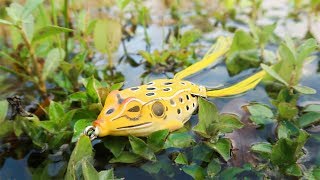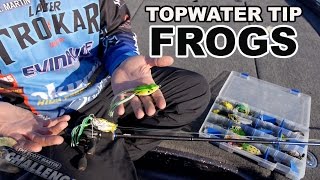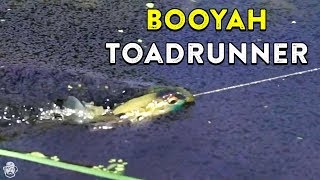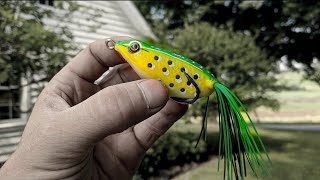how to use a topwater frog bait
One of the greatest mistaken beliefs of frog fishing is that the frog is supposed to represent a frog. Anglers need to bear in mind that more times than not, bass are eating bream, shad and other baitfish, so "matching the hatch" is essential. Understanding this, an angler can generally get away with simply 3 colors for any bass fishing water in the country: white, black, and some sort of "bluegill" color.
When to Utilize a Black Frog: This is my go-to for muddy water, as it assists create a more specified silhouette that fish can see easier. When to Use a Bluegill-Colored Frog: This is an obvious color option when fish are up shallow feeding on bream, and when fishing around bream beds.
When it comes to gear and frog fishing, it is essential to think about where you're fishing. Pads and reeds will break more hearts than James Bond, so you're going to desire to beef up your rod and line when fishing around this line consuming cover. I typically advise 65-pound braid and a heavy action rod for this scenario.
Kristine Fischer Many frogs are rigid when they are new, and this might avoid you from getting a solid hookset. To make the frog "collapse" better, place the plastic body of the frog in boiling water for a few seconds. This will soften the body and help the hook penetrate better.
Long legs create drag in the water and make it very hard to walk the frog. I like keeping the length, so I vary the trim on the strands to where I am "thinning" the legs without eliminating excessive length. Kristine Fischer Ish Monroe is among the top frog bait fishermen in the country.
With 9 majors and 51 top 10s, his career revenues overall over $2. 2 million. We sat down with Monroe to discover out how he catches bass with frog baits. Here is what he had to say. Is it best to keep frogs moving or let it sit? How do I understand which to do? Let the fish determine what they want.
Fish have to determine and you will require to experiment to figure it out. Do you set the hook in a different way when fishing frogs instead of other lures? With the frog, you wish to set the hook at 1 o'clock or 11 o'clock; never swing to 3 o'clock or downward so you can be sure to hook the fish in the top of the mouth.
The frog is a really flexible lure. One of the most significant keys to mastering them is to learn to "walk the frog." Frogs can be excellent in open water due to the fact that they're subtle. A lot of guys will throw topwater baits, like a Spook, however a bass may not desire something that loud.
However I toss the frog a lot in open water or along open shorelines. It's excellent in those scenarios. Coastline riprap along road causeways is among my preferred targets in the pre-spawn, generate, and post-spawn periods. Usually, fish are on or near tough bottom, forage is plentiful, and bass can spawn on or near the rocks.
Those same locations often get pockets of wind-blown plant life previously in the year, too. What's the very best time to fish a frog bait for bass? Anytime the water temperature is regularly 56 degrees or more, for me it's video game on," Monroe states. "It can be overcast or warm, morning, twelve noon, or nightthey will eat a frog.
If I can't see it, then they can't see it. If the wind is blowing and waves are rolling, they can't home in on it. There's too much going on. But if it's calm or there's just a little ripple, they can see it and will come consume it." Do you ever use aromas with frogs? No fragrances at all.
What size frog bait should I use and when? I make the Ish Monroe River2Sea Phat Mat Daddy frog in one size since it's the only size you require. During Phase 3 of the Bass Pro Tour in March, when I caught eight scorable bass for 34 pounds on day one, it was all with the frog.
Now, I am not saying you just require to bring one rod with you to the lake. It's just that I prefer the frog, and feel as though I will get larger bites on it. Bass have eyes that are positioned pointing up and are programmed to feed that way more so than looking down.
Among the biggest errors I see other anglers make, in my viewpoint, is to put the frog down when the sun shows up. In many instances, this is when the frog bite will excel as the bass will position themselves in the shade of the grass, low-hanging trees or a boat dock.
When I am fishing a lake that has an abundance of turf, I will constantly choose for a frog. Now, when I am fishing a tournament, the 10-20 bite ratio goes out the window as we are trying to win. It is constantly helpful for you and your partner to throw various discussions and cover the location you are fishing the most effectively.
He can absolutely lay a jig, Texas Rig or a Senko beside a tree or stump with surgical accuracy. So, it works to our benefit to have him turning and me frogging. That method we both aren't attempting to essentially capture the same fish, and we will cover more water by doing this.
He has far more confidence in his presentations, and I have more self-confidence with the frog. Day in and out, self-confidence will cash your checks. When you get a bite on a 10-inch worm, you truly have no idea how big the fish is for the very first 5-10 seconds. When a fish blows up on your frog like a landmine, you have a respectable idea of how huge it was.
A frog is not actually a frog either. As I discussed, it can represent a bird, shad, bream, crappie, mouse or yes, a frog. The bass looks up and states, "I think I can consume that thing." And for the a lot of part he is. I feel as though I can capture the most significant bass around when there is an abundance of yard or pads on a frog.
More on that in a moment. Sturdiness and buoyancy are top-notch, and you can expect seasons of efficiency for your money. Its 4/0 hooks are close and tight as they must be, and this little guy tracks well. If you're fretted that the 3/0 hooks on the Booyah are too little, this may be the better choice for you.
You desire to do precisely that. When a bass does strike your frog, you'll be tempted to set the hook instantly. Pause for simply a second or two, let that fish truly get a grip, and then set your hook. You'll enhance the hook set and land more fish if you do.
Soft-bodied frogs take a beating when they get hit, and you desire a long lasting lure that can last a season or more. We'll suggest frogs that keep their legs hit after hit, and in this regard, we offer the edge to tasseled styles. Preferably, your topwater frog will sit in the water just like the genuine thing, neither floating notably high nor sitting too low and sinking.
While there are other frogs on the marketplace, many just don't make the cut. Some fill with water and sink, others break down after a few hits, and still others run in circles or snag weeds like a huge treble. These are our top choices, and we 'd toss all of them without a concern.
And please leave a comment listed below!.
Last Upgraded on August 25, 2022 We separately research, test, and suggest the very best products; you can find out more about our evaluation process here. As bass anglers, there's one thing that we enjoy, and that's weedy, mucky, sloppy backroad ponds in the middle of no place. This is where the finest bass fishing is, and to fish this type of water, you require the very best bass frog lure.
These are towards the top when it concerns the very best topwater tempts when fishing in vegetated water, but that doesn't mean you're just minimal to that. You can tempt the finest frog baits in deep water and around structure as well. Below are our best frogs for bass fishing.
Size/Weight: 1. 75/ 2/ 2. 25 inches, Color: 10 various color variations included specifications The hollow style allows these to easily skim across the water, that makes them a perfect frog for bass in the weeds. EXTRA FEATURES They have a soft body building and construction that not only conceals the hooks, however it permits a natural feel when bass bite down on them.
Take note of the frogs you see on the water around you and mimic that. Many various colors with realistic patterns, Excellent choice in the slop, Great for huge bass Possible sturdiness issues One of my favorite features of frog lures for bass is how realistic they look as they move through the water.
Realistic appearance and discussion, Appears like a real frog, The soft body triggers bass to strike harder There's a little bit of a knowing curve If you believed it could not get anymore real than some of the frog baits we have actually shared up until now, you're wrong. This one is incredibly realistic, and my favorite aspect of it is the legs.
Size/Weight: 1. 6 ounces (some say it runs a bit small)Color 5 various color variations FEATURED specifications Comes with a popper on the front, which produces a bubble path in the water and makes a lot of noise. ADDITIONAL FEATURES It features 2 hooks on the rear of the frog, which makes it easy to set the hook.
These make a great deal of noise when they struck the water, so they work much better in open water. Great for open water topwater fishing, Makes a great deal of noise, Practical look The main distinction between this lure and the rest is the cup on the front. When you cast this into the water, it makes a loud pop sound, and it continues to do that as you obtain it.
I would recommend taking one these and rigging it down the rear and just moving through the greenery and see what takes place. When it concerns fishing frogs for bass, you're limited to two various types. You have actually got basic skirting frogs that will navigate through the weediest bodies of water, and these been available in both hollow bodies and soft bodies.
This implies you can run through the sloppiest of water without catching and bringing a lots of weeds with you. When you attempt to fish other kinds of lures like spinnerbaits, crankbaits, or jigs in heavy plants, you grab a heap of slop and pull it. This not just makes you question if there's a fish at the end, however it totally screws up your discussion and makes sure that a fish will never ever bite.





